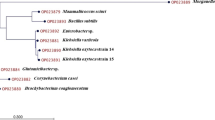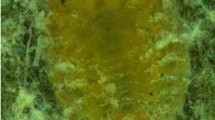Abstract
The pink mealybug Maconellicoccus hirsutus (Green) (Hemiptera: Pseudococcidae) is a polyphagous insect pest with protective wax covering. Bacterial isolates originating from M. hirsutus cadavers were screened for their wax degrading effects and the three most potent wax degrading isolates were identified to be Serratia marcescens, Pseudomonas aeruginosa and Bacillus subtilis by 16S rRNA gene sequencing. Bacteria degrading M. hirsutus wax reduced female longevity, offspring production as well as weight and wax content of emerging adults. Treatment with S. marcescens was the most effective in reducing wax content, fecundity and honeydew production. Analysis of honeydew produced by M. hirsutus after each microbial treatment revealed reduction in amino acids, proteins, and reducing sugars concentration compared to controls. Most negative effect on reducing sugars was observed in the B. subtilis treatment suggesting disequilibrium in mealybug metabolism. S. marcescens and P. aeruginosa treatments showed significantly lower content of wax as compared to control suggesting utilization of wax as carbon source by these microorganisms. This study suggests that the use of each of three bacterial isolates reduces wax content of mealybug and might be useful in devising mealybug control strategies.
Similar content being viewed by others
References
Aristizábal LF, Catharine M, Christopher B, Steven A (2012) Life history of pink hibiscus mealybug, Maconellicoccus hirsutus (Hemiptera: pseudococcidae) on three Hibiscus rosa-sinensis cultivars. Fla Entomol 95(1):89–94
Balikai RA, Bagali AN (2000) Population density of mealybug, Maconellicoccus hirsutus on ber (Zizyphus mauritiana) and economic losses. Agric Sci Dig 20:62–63
Bano N, Musarrat J (2003) Characterization of a new Pseudomonas aeruginosa strain NJ-15 as a potential biocontrol agent. Curr Microbiol 46:324–328
Bennett JW, Bentley R (2000) Seeing red: the story of prodigiosin. Adv Appl Microbiol 47:1–32
Bradford MM (1976) Rapid and sensitive method for the quantization of microgram quantities of protein utilizing the principle of protein-dye binding. Anal Biochem 72:248–254
Browne CA, Zerban FW (1941) Physical and chemical methods of sugar analysis: a practical and descriptive treatise for use in research, technical, and control laboratories, 3rd edn. Wiley, New York, USA
Chong J, Roda A, Mannion CM (2008) Life history of the mealybug, Maconellicoccuss hirsutus (Green) (Hemiptera: Pseudococcidae), at constant temperature. Environ Entomol 37:323–332
de Maagd RA, Weemen-Hendriks M, Stiekema W, Bosch D (2000) Bacillus thuringiensis deltaendotoxin Cry1C domain III can function as a specificity determinant for Spodoptera exigua in different, but not all, Cry1–Cry1C hybrids. Appl Environ Microbiol 66(4):1559–1563
Demirci F, Mustu M, Kaydan MB, Ulgenturk S (2011) Laboratory evaluation of the effectiveness of the entomopathogen; Isaria farinosa, on citrus mealybug, Planococcus citri. J Pest Sci 84:337–342
EPPO (2005) European and mediterranean plant protection organization data sheets on quarantine pests Maconellicoccus hirsutus. EPPO Bull/Bull OEPP 35:413–415
Franz JM (1970) Biological and integrated control of pest organisms in forestry. Unasylva 24. FAO corporate document respository
Garland JA (1998) Pest risk assessment of the pink mealybug Maconellicoccus hirsutus (Green), with particular reference to Canadian greenhouses. PRA 96-21. Canadian Food Inspection Agency, Ottawa, Canada
Ghose K (1972) Biology of the mealybug, Maconellicoccus hirsutus Green (Pseudococcidae: Hemiptera). Indian Agric 16:323–332
Gullan PJ, Kosztarab M (1997) Adaptations in scale insects. Annu Rev Entomol 42:23–50
Hall WJ (1926) The Hibiscus mealybug (Phenacoccus hirsutus, Green) in Egypt in 1925 with notes on the introduction of Cryptolaemus montrouzieri, Muls. Ministry of Agriculture, Egypt. Tech Scientific Serv Bull No 70:1-15
Harley JP, Prescott LM (1996) Laboratory exercise in microbiology, 3rd edn. McGraw-Hill, New York, USA
Holt JG (1994) Bergey’s manual of determinative bacteriology, 9th edn. Williams & Wilkins, Baltimore, USA, pp 1–787
Ibargutxi MA, Muñoz D, Escudero IRD, Caballero P (2008) Interactions between Cry1Ac, Cry2Ab, and Cry1Fa Bacillus thuringiensis toxins in the cotton pests Helicoverpa armigera (Hübner) and Earias insulana (Boisduval). Biol Control 47(1):89–96
Jackson TA, Glare TR, O’Callaghan M (1991) Pathotypic boundaries for Serratia spp. causing amber disease in the New Zealand grass grub, Costelytra zealandica. IOBC/WPRS Bull XIV(7):148–152
Jeong HU, Mun HY, Oh HK, Kim SB, Yang KY, Kim I, Lee HB (2010) Evaluation of insecticidal activity of a bacterial strain, Serratia sp. EML-SE1 against diamondback moth. J Microbiol 48:541–545
Kairo MTK, Pollard GV, Peterkin DD, Lopez VF (2000) Biological control of the hibiscus mealybug, Maconellicoccus hirsutus in the Caribbean. Int Pest Manag 5:241–254
Lane DJ (1991) 16S/23S rRNA sequencing. In: Stackebrandt E, Goodfellow M (eds) Nucleic acid techniques in bacterial systematics. Wiley, New York, USA, pp 115–148
Larkin MA, Blackshields G, Brown NP, Chenna R, McGettigan PA, McWilliam H, Valentin F, Wallace IM, Wilm A, Lopez R, Thompson JD, Gibson TJ, Higgins DG (2007) Clustal W and clustal X version 2.0. Bioinformatics 23:2947–2948
Leger RJS, Charnley AK, Cooper RM (1986) Cuticle-degrading enzymes of entomopathogenic fungi: synthesis in culture on cuticle. J Invertebrate Pathol 48:85–95
Lysyk TJ, Kalischuk-Tymensen LD, Selinger LB (2002) Comparison of selected growth media for culturing Serratia marcescens, Aeromonas sp., and Pseudomonas aeruginosa as pathogens of adult Stomoxys calcitrans (Diptera: Muscidae). J Med Entomol 39:89–98
Mani M (1989) A review of the pink mealybug Maconellicoccus hirsutus. Insect Sci Appl 10:157–167
Manjunath TM (1985) India-Maconellicoccus hirsutus on grapevine. FAO Plant Prot Bull 33:74
Marks GS, Bogorad L (1960) Studies on the biosynthesis of prodigiosin in Serratia marcescens. Proc Natl Acad Sci USA 46:25–28
Meyerdirk DE, Warkentin R, Attavian B, Gersabeck E, Francis A, Adams M, Francis G (1998) Biological control of the pink hibiscus mealybug project manual. United States Department of Agriculture, Washington, DC, USA
Miller GL (1972) Use of dinitrosalicylic acid reagent for determination of reducing sugar. Anal Chem 31(3):426–428
Minaxi, Saxena J (2010) Characterization of Pseudomonas aeruginosa RM-3 as a potential biocontrol agent. Mycopathologia 170:181–193
Moore S, Stein WH (1948) Photometric ninhydrin method for use in the chromatography of amino acids. J Biol Chem 176:367–388
Muralidharan CM, Badaya SN (2000) Mealybug (Maconellicoccus hirsutus) outbreak on herbaceum cotton (Gossypium herbaceum) in wagad cotton belt of kachch. Indian J Agric Sci 70:705–706
Patel IS, Dodia DA, Patel SN (1990) First record of Maconellicoccus hirsutus as a pest of pigeonpea (Cajanus cajan). Indian J Agric Sci 60:645
Patil SV, Salunke BK, Patil CD, Salunkhe RB, Gavit P, Maheshwari VL (2010) Potential of extracts of the tropical plant Balanites aegyptiaca (L) Del. (Balanitaceae) to control the mealybug, Maconellicoccus hirsutus (Homoptera: Pseudococcidae). Crop Prot 29:1293–1296
Patil CD, Patil SV, Salunke BK, Salunkhe RB (2011a) Prodigiosin produced by Serratia marcescens NMCC46 as a mosquito larvicidal agent against Aedes aegypti and Anopheles stephensi. Parasitol Res 109(4):1179–1187
Patil SV, Patil CD, Salunkhe RB, Maheshwari VL, Salunke BK (2011b) Studies on life cycle of mealybug, Maconellicoccus hirsutus (Green) (Hemiptera: Pseudococcidae), on different hosts at different constant temperatures. Crop Prot 30:1553–1556
Patil CD, Patil SV, Salunke BK, Salunkhe RB (2012) Insecticidal potency of bacterial species Bacillus thuringiensis SV2 and Serratia nematodiphila SV6 against larvae of mosquito species Aedes aegypti, Anopheles stephensi, and Culex quinquefasciatus. Parasitol Res 110(5):1841–1847
Petra T, Frank R, Susanne W, Karl EJ, Hans C, Jost W (2010) Extracellular enzymes affect biofilm formation of mucoid Pseudomonas aeruginosa. Microbiology 156:2239–2252
Raju AK, Rao PRM, Apparao RV, Readdy AS, Rao KKP (1988) Note on estimation of losses in yield of mesta due to mealybug, Maconellicoccus hirsutus. Jute Dev J 8:34–35
Sambrook J, Fritsch EF, Maniatis T (1989) Molecular cloning: a laboratory manual, 2nd edn. Cold Spring Harbor Laboratory, New York, USA
Steinhaus EA (1959) Serratia marcescens Bizio as an insect pathogen. Hilgardia 28:351–380
Williams DJ (1985) Australian mealybugs. British Museum (Natural History), London, UK
Williams DJ (1996) A brief account of the hibiscus mealybug Maconellicoccus hirsutus, a pest of agriculture and horticulture, with descriptions of two related species from southern Asia. Bull Entomol Res 86:617–628
Xia X, Xie Z (2001) DAMBE: data analysis in molecular biology and evolution. J Hered 92:371–373
Xie Y, Zheng L (2002) The chemical composition of waxes secreted by a Scale insect Eriopeltis festucae (Homoptera: Coccoidea). Acta Scient Nat Univ Nankaiensis 35:1–6
Acknowledgments
The Financial assistance to Dr. Satish V. Patil in the form Project Grant File No. (BT/PR12694/AGR/05/474/(letter II) dated 30 June 2010) from Department of Biotechnology (DBT), Ministry of Science and Technology, Government of India is gratefully acknowledged.
Author information
Authors and Affiliations
Corresponding author
Additional information
Handling Editor: Nicolai Meyling.
Rights and permissions
About this article
Cite this article
Salunkhe, R.B., Patil, C.D., Salunke, B.K. et al. Effect of wax degrading bacteria on life cycle of the pink hibiscus mealybug, Maconellicoccus hirsutus (Green) (Hemiptera: Pseudococcidae). BioControl 58, 535–542 (2013). https://doi.org/10.1007/s10526-013-9513-3
Received:
Accepted:
Published:
Issue Date:
DOI: https://doi.org/10.1007/s10526-013-9513-3




